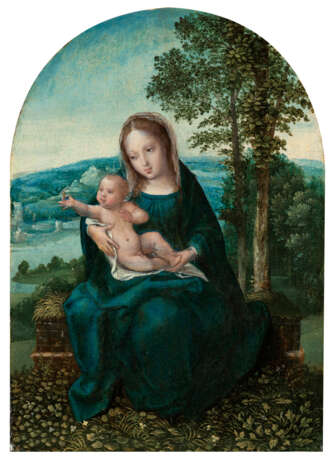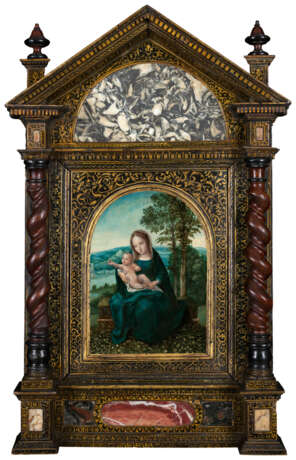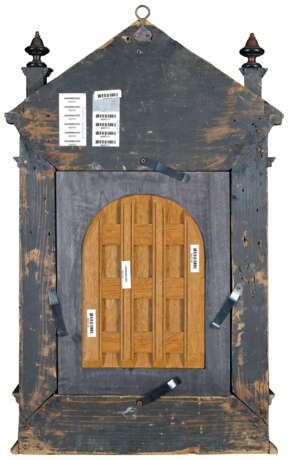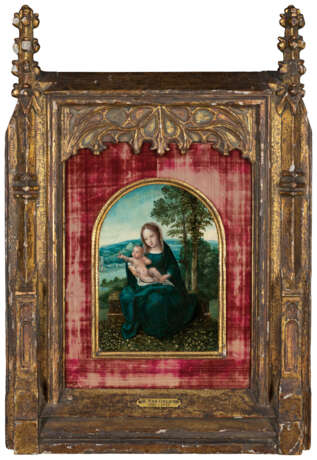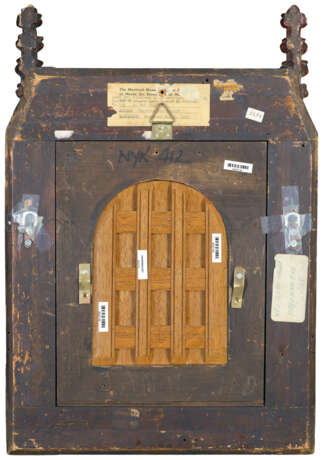ID 974975
Lot 11 | BERNARD VAN ORLEY (BRUXELLES VERS 1488-1541)
Estimate value
€ 150 000 – 250 000
Vierge à l'Enfant
présenté dans un cadre de prêt néo-Renaissance (photos 2 et 3)
vendu avec un cadre néo-gothique (photos 4 et 5)
huile sur panneau, cintré dans la partie supérieure
20,1 x 14,5 cm. (7 15⁄16 x 5 11/16 in.)
Provenance
Louis Clark(e), Londres.
Acquis à ce dernier par Thos. Agnew & Sons, Londres et Berlin, 1908-1909 (comme 'Adriaen Isenbrant' (selon les archives de Thomas Agnew & Sons 1899-1919, p. 16, n°2777) puis 'Bernard van Orley' (selon H. Voss, 1909, op. cit. infra).
Martin (1850-1918) et Leonore (1852-1927) Bromberg, Hambourg, en 1909 ; puis par descendance à Dr. Henry (1878-1971) et Hertha (1899-1964) Bromberg, Hambourg.
Acquis à ces derniers par Allan Loebl pour la galerie F. Kleinberger, Paris, avant le 20 décembre 1938 (selon une lettre écrite par A. Loebl à Harry Sperling (1906-1971) le 20 décembre 1938) ; d'où acquis par James P. Labey (mort en 1946), le 21 avril 1939, New York (pour $ 800) (selon Kleinberger Galleries Records (Metropolitan Museum of Art, New York), Card n°291), probablement pour Elwood Bigelow Hosmer (1879-1947), Montréal, en avril 1939 ; puis par descendance à la soeur d'E. B. Hosmer, Olive Osmer (1880-1962), Montréal ; puis par descendance à sa nièce, Lucile Elizabeth Pillow, née Fairbank (1883-1969), Montréal ; puis par descendance à sa fille, Lucinda Marguerite Pillow (1903-1991) et son époux, A. Murray Vaughan (1899-1986), Montréal.
Vente anonyme, Christie's, New York, 11 janvier 1979, lot 110 (comme 'Bernard van Orley') ; d'où acquis par une collection particulière, Philadelphie.
J. O. Leegenhoek, Paris, vers 1990 (comme 'Bernard van Orley') (selon une note à la Documentation des Peintures du Louvre).
Vente anonyme, Sotheby's, New York, 11 janvier 1990, lot 14 (comme 'Barent van Orley') ; d'où acquis par un collectionneur particulier.
Acquis à ce dernier par l'actuel propriétaire, en 2019.
Literature
H. Voss, 'Gemälde alter Meister bei Thomas Agnew & Sons in Berlin', Der Cicerone, janvier 1909, 1ère année, heft 17, pp. 549-550 (comme 'Bernard van Orley'), reproduit en noir et blanc p. 551.
Kunstgegenstände im Hause des Herrn Martin Bromberg, Hambourg, 1913, n°1.
Exhibited
Montréal, musée des beaux-arts, autour du 8 mai 1969, n°108 (comme 'B. van Orley') (selon une étiquette au revers du cadre).
Paris, J. O. Leegenhoek, Exposition de maîtres flamands des XVIe et XVIIe siècles, autour de septembre 1990 (comme 'Bernard van Orley') (selon une note à la Documentation des Peintures du Louvre).
Post lot text
BERNARD VAN ORLEY, VIRGIN AND CHILD, OIL ON PANEL, ARCHED TOP
The format and iconography of this small panel suggest that Bernard van Orley's Virgin and Child (c. 1488-1541) was conceived as the right-hand side of a diptych, the other side of which would have depicted St Catherine of Alexandria, given that the Christ Child is holding out a ring as if in offering, symbolic of the mystical marriage as recounted by Friar John of Bungay in his English translation (1438) of The Golden Legend by James de Voragine (c. 1230-c. 1298).
The painting dates to the first decade Bernard van Orley's career, around 1510-1515. This period was marked by painting, mainly in response to commissions from ecclesiastics. (His first cartoons for tapestries date from 1518, corresponding to his appointment as court painter by Margaret of Austria (1480-1530).) The earliest works that can be attributed to him are three pairs of shutters held in various collections, including the Marriage of the Virgin (National Gallery of Art, Washington DC, no. inv. 1952.5. 48) and Christ among the Doctors / Putto bearing the Coat of Arms of Abbé Jacques Coëne (National Gallery of Art, Washington DC, inv. no. 1952.5.44) painted by the artist for Jacques Coëne, the abbé de Marchiennes (see A. Galand, 'Les commandes religieuses', in V. Bücken, I. De Meûter (eds.), Bernard van Orley, [exh. cat.], Brussels, Palais des Beaux-Arts, 2019, pp. 80-89).
A note on the provenance.
Through his mother Eleonore Kann (1852-1927), Dr. jur. Henry Bromberg (1878-1971) belonged to the family of the famous collector Rodolphe Kann (1845-1905). This important family also included the Emdens. Henry's father, the industrialist Martin Bromberg (1850-1918), had a large collection of old master paintings and decorative arts, (described in Kunstgegenstände im Hause des Herrn Martin Bromberg, Hamburg, 1913, op. cit. supra), which was expanded by his son. The latter lived in a large house in Hamburg-Eppendorf with his wife, Hertha née Calmon (1899-1964), and their four sons.
When the Nazis came to power, the Brombergs were faced with increasing restrictions and persecution of the Jewish community in Germany. In order to prepare for emigration to the United States via Switzerland, the couple was forced to sell a number of works from the family collection to the Paris-based dealer Allen Loebl in December 1938 (see letter written by Allen Loebl to Harry Sperling on 20 December 1938).
The present painting, given to Bernard van Orley, was part of this forced sale. Martin Bromberg had acquired it some thirty years earlier (1909) in Berlin from Thomas Agnew & Sons. In March 1939, Loebl travelled to New York with all the works acquired from the Bromberg family, including the Virgin and Child. A month later, it was purchased in New York by the London art dealer James P. Labey (d. 1946) for an anonymous client (Kleinberger Galleries Records, Metropolitan Museum of Art, New York, Card no. 291), most likely Elwood Bigelow Hosmer (1879-1947), manager of the Ritz-Carlton in Montreal (hence his nickname "Grey Ghost of the Ritz"), who had inherited a large collection of paintings from his father, mainly Flemish primitives but also English portraits and nineteenth-century French paintings. An avid collector, he was appointed to the Board of Trustees of the National Gallery of Canada in Ottawa in 1933. On his death, his sister Olive Hosmer (1880-1962) inherited the collection, which she bequeathed in 1962 to Lucile Elizabeth Pillow, née Fairbank (1883-1969). Upon her death, The Virgin and Child became the property of her daughter, Lucinda Marguerite Pillow (1903-1991) and her husband, A. Murray Vaughan (1899-1986), who had been president of the Montreal Museum of Fine Arts between 1963 and 1968, which would explain the loan of the painting to the museum in May 1968. Part of the Hosmer-Pillow collection, including the present painting, was sold at auction in January 1979 (anonymous sale, Christie's, New York, 11 January 1979, lot 110).
| Artist: | Bernard van Orley (1488 - 1541) |
|---|---|
| Applied technique: | Oil on panel |
| Art style: | Old Masters |
| Place of origin: | Belgium, Western Europe, Europe |
| Auction house category: | Paintings |
| Artist: | Bernard van Orley (1488 - 1541) |
|---|---|
| Applied technique: | Oil on panel |
| Art style: | Old Masters |
| Place of origin: | Belgium, Western Europe, Europe |
| Auction house category: | Paintings |
| Address of auction |
CHRISTIE'S 9 Avenue Matignon 75008 Paris France | ||||||||||||||
|---|---|---|---|---|---|---|---|---|---|---|---|---|---|---|---|
| Preview |
| ||||||||||||||
| Phone | +33 (0)1 40 76 85 85 | ||||||||||||||
| Fax | +33 (0)1 40 76 85 86 | ||||||||||||||
| Conditions of purchase | Conditions of purchase | ||||||||||||||
| Shipping |
Postal service Courier service pickup by yourself | ||||||||||||||
| Payment methods |
Wire Transfer | ||||||||||||||
| Business hours | Business hours
|
